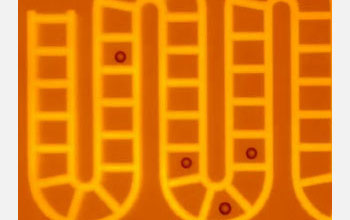|

Press Release 05-123
High-Tech Tool Maneuvers Microscopic Particles

Optical conveyor belt moves 15,000 micron-sized objects all at once
July 20, 2005
Researchers have invented so-called optoelectronic tweezers that can maneuver microscopic particles as small as living cells without damaging them. The tool uses optical energy from a low-intensity laser beam to create an electric field on a photoconductive glass slide. Similar to magnets sticking together or pushing apart according to their orientation, a particle inside the charged electric field is attracted or repelled depending on its own charge. Moving the laser beam moves the electric field, taking the object along with it.
University of California, Berkeley professor, Ming Wu, together with graduate students Pei Yu Chiou and Aaron Ohta, describe the new device in the July 21 issue of the journal, Nature.
The light from the laser can be projected into a variety of shapes and sizes providing imaginative scientists with all sorts of possibilities for moving, sorting and trapping micron-sized objects. Wu has even developed an optical conveyor belt with individual compartments to transport particles.
Ohta, whose research and training is supported by the National Science Foundation, works closely with Chiou on this project. Together, they were graduate finalists in the 2004 Collegiate Inventors Competition. The international contest, sponsored by the U.S. Patent and Trademark Office, encourages students to actively practice science, engineering and mathematics for creative invention of patentable products.
For more information, see the complete story at the University of California, Berkeley news center.
-NSF-

Media Contacts
Richard (Randy) Vines, NSF (703) 292-7963 rvines@nsf.gov
Sarah Yang, University of California, Berkeley (510) 643-7741 scyang@berkeley.edu
Principal Investigators
Ming Wu, University of California, Berkeley 510 643-0808 wu@eecs.berkeley.edu

The National Science Foundation (NSF) is an independent federal agency that
supports fundamental research and education across all fields of science and
engineering, with an annual budget of $6.06 billion. NSF funds reach all 50
states through grants to over 1,900 universities and institutions. Each year,
NSF receives about 45,000 competitive requests for funding, and makes over
11,500 new funding awards. NSF also awards over $400 million in
professional and service contracts yearly.
 Get News Updates by Email Get News Updates by Email
Useful NSF Web Sites:
NSF Home Page: http://www.nsf.gov
NSF News: http://www.nsf.gov/news/
For the News Media: http://www.nsf.gov/news/newsroom.jsp
Science and Engineering Statistics: http://www.nsf.gov/statistics/
Awards Searches: http://www.nsf.gov/awardsearch/
| 

